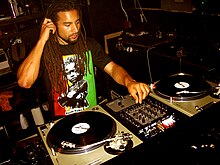Characteristics
Dubstep's early roots are in the more experimental releases of UK garage producers, seeking to incorporate elements of drum and bass into the South London-based 2-step garage sound. These experiments often ended up on the B-side of a white label or commercial garage release.[5][8][9] Dubstep is generally instrumental. Similar to a vocal garage hybrid - grime - the genre's feel is commonly dark; tracks frequently use a minor key and can feature dissonant harmonies such as the tritone interval within a riff. Other distinguishing features often found are the use of samples, a propulsive, sparse rhythm,[10] and an almost omnipresent sub-bass. Some dubstep artists have also incorporated a variety of outside influences, from dub-influenced techno such as Basic Channel to classical music or heavy metal.[10][11][12]
Rhythm
Dubstep rhythms are usually syncopated, and often shuffled or incorporating tuplets. The tempo is nearly always in the range of 138-142 beats per minute, with a clap or snare usually inserted every third beat in a bar.[10] In its early stages, dubstep was often more percussive, with more influences from 2-step drum patterns. A lot of producers were also experimenting with tribal drum samples, an example being Loefah's early release "Truly Dread".
In an Invisible Jukebox interview with The Wire, Kode9 commented on a DJ MRK1 (formerly Mark One) track, observing that listeners "have internalized the double-time rhythm" and the "track is so empty it makes [the listener] nervous, and you almost fill in the double time yourself, physically, to compensate".[13]
Wobble bass
One characteristic of certain strands of dubstep is the wobble bass, where an extended bass note is manipulated rhythmically. This style of bass is typically produced by using a low frequency oscillator to manipulate certain parameters of a synthesizer such as volume, distortion or filter cutoff. The resulting sound is a timbre that is punctuated by rhythmic variations in volume, filter cutoff, or distortion. This style of bass is a driving factor in some variations of dubstep, particularly at the more club-friendly end of the spectrum.[14]
Structure, bass drops, rewinds and MCs

Originally, dubstep releases had some structural similarities to other genres like drum and bass and UK garage. Typically this would comprise an intro, a main section (often incorporating a bass drop), a midsection, a second main section similar to the first (often with another drop), and an outro.
Many early dubstep tracks incorporate one or more "bass drops", a characteristic inherited from drum and bass. Typically, the percussion will pause, often reducing the track to silence, and then resume with more intensity, accompanied by a dominant subbass (often passing portamento through an entire octave or more, as in the audio example). It is very common for the bass to drop at or very close to 55 seconds into the song, due to the fact that 55 seconds is just over 32 measures at the common tempo of 140 bpm. However, this (or the existence of a bass drop in general) is by no means a completely rigid characteristic, rather a trope; a large portion of seminal tunes from producers like Kode9 and Horsepower Productions have more experimental song structures which don't rely on a drop for a dynamic peak - and in some instances don't feature a bass drop at all.
Rewinds (or reloads)[15] are another technique used by dubstep DJs. If a song seems to be especially popular, the DJ will 'spin back' the record by hand without lifting the stylus, and play the track in question again. Rewinds are also an important live element in many of dubstep's precursors; the technique originates in dub reggae soundsystems, is a standard of most pirate radio stations and is also used at UK garage and jungle nights.[16]
Taking direct cues from Jamaica's lyrically sparse deejay and toasting mic styles in the vein of reggae pioneers like U-Roy, the MC's role in dubstep's live experience is critically important to its impact.[17]
Notable mainstays in the live experience of the sound are MC Sgt Pokes and MC Crazy D from London, and Juakali from Trinidad.[18][19][20][21] Production in a studio environment seems to lend itself to more experimentation. Kode9 has collaborated extensively with the Spaceape, who MCs in a dread poet style. Kevin Martin's experiments with the genre are almost exclusively collaborations with MCs such as Warrior Queen, Flowdan, and Tippa Irie. Skream has also featured Warrior Queen and grime artist JME on his debut album, Skream!. Plastician, who was one of the first DJ's to mix the sound of grime and dubstep together,[11] has worked with notable grime setup Boy Better Know as well as renowned Grime MC's such as Wiley, Dizzee Rascal and Lethal Bizzle. He has also released tracks with a dubstep foundation and grime verses over the beats.[22] Coki and Mala of Digital Mystikz have experimented with abrupt, 16-bar intros and have produced tracks with dub vocalists,[citation needed] and dubstep artist and label co-owner Sam Shackleton has moved toward productions which fall outside the usual dubstep tempo, and sometimes entirely lack most of the common tropes of the genre.[23]